Ever thought you nailed that email, only to cringe at common grammar mistakes after hitting send?
Or perhaps you drafted an essay so captivating it would make Hemingway weep, but then watched in horror as red squiggles of spelling and grammar checks defaced your masterpiece?
You’re not alone. Whether it’s confusing “lose” with “loose”, tripping up on dangling modifiers, or treating commas like confetti — we’ve all been there.
In this English grammar guide, we’ll arm you with the knowledge to conquer those pesky errors that slip under the radar.
By the end of this piece, you’ll be crafting sentences that glide smoothly off the tongue rather than annoying readers with unexpected blunders.
Table Of Contents:
- 12 Most Common Grammar Mistakes
- 1. Sentence Fragments
- 2. Comma Splices
- 3. Run-on Sentences
- 4. Verb Tense Inconsistency
- 5. Dangling and Misplaced Modifiers
- 6. Incorrect Title Capitalization
- 7. Mixing Up Possessive Nouns and Contractions
- 8. Missing Commas with Transition Words
- 9. Misusing Coordinating Conjunctions
- 10. Mixing Up Hyphens and Dashes
- 11. Incomplete Comparisons
- 12. Mixing Up Homonyms
- Conclusion
12 Most Common Grammar Mistakes
Grammatical errors, though seemingly harmless, can have various consequences, ranging from minor misunderstandings to lost job opportunities — and even legal disputes!
Grammar errors can confuse readers and distort your message. Unfortunately, even the best writers make common grammar mistakes. The key is recognizing them and learning how to fix them.
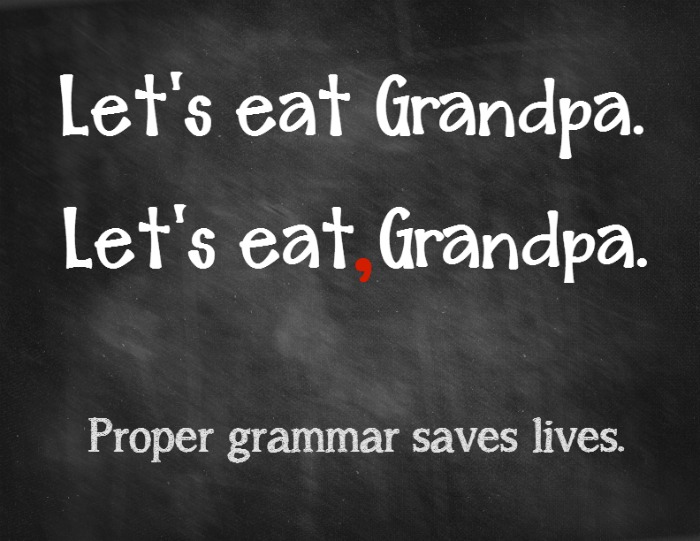
A friendly reminder from the Jefferson Community College
1. Sentence Fragments
Let’s talk sentence fragments.
A sentence fragment is an incomplete thought masquerading as a full sentence. It lacks either a subject or verb, sometimes both.
Examples:
❌ After the rain stopped. (Lacks a main verb)
❌ Because she loves to travel. (Lacks a main subject and verb)
❌ In the corner of the room. (Lacks a subject and verb)
❌ Excited about the news that he received yesterday. (Lacks a main subject and verb)
❌ The old house with the red door and the overgrown garden. (Lacks a main verb)
Fix these fragments by turning them into complete sentences:
✅ After the rain stopped, she went for a walk.
✅ Because she loves to travel, she plans to visit Europe next summer.
✅ In the corner of the room, there was an old bookshelf.
✅ Excited about the news that he received yesterday, he called his friends to share it.
✅ The old house with the red door and the overgrown garden looked charming in the sunlight.
Fixing these common grammar mistakes isn’t rocket science. The solution lies in adding what’s missing – whether that’s the subject or verb – thus turning a fragmented idea into a complete idea.
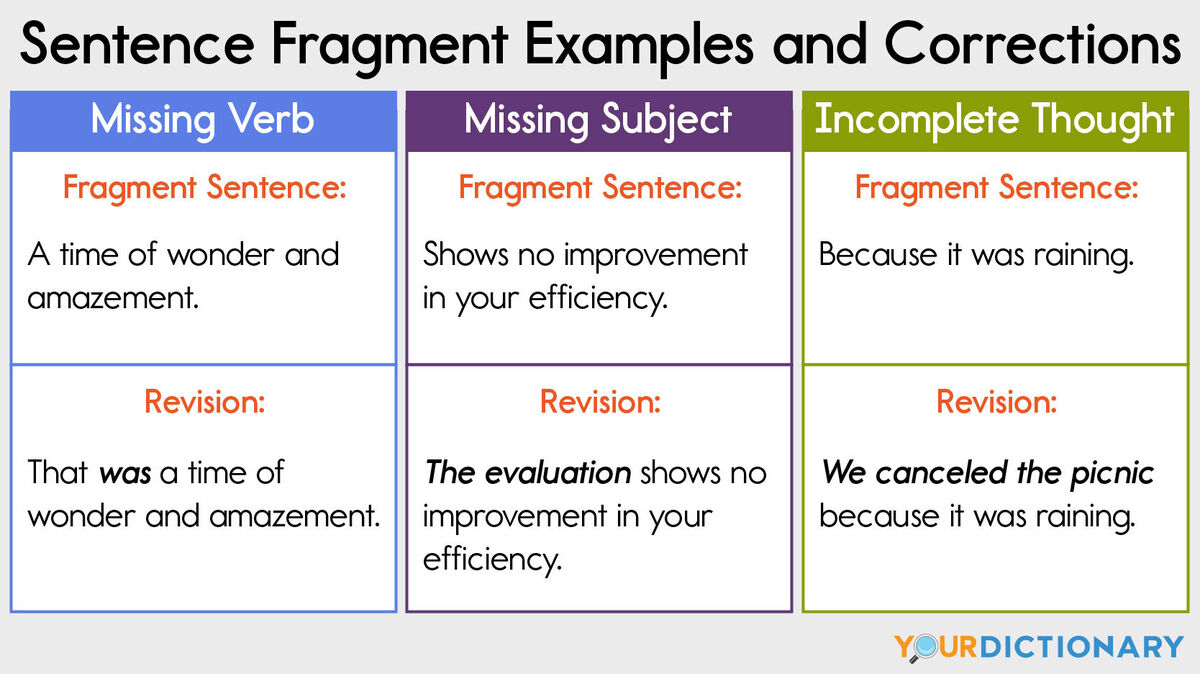
More examples of sentence fragments from Your Dictionary
2. Comma Splices
Comma splices occur when two independent clauses (complete sentences) are joined together with only a comma, without the appropriate conjunction (and, or, but), or without a semicolon.
Examples:
❌ She likes to read, he prefers to watch movies.
❌ The concert was fantastic, everyone enjoyed it immensely.
❌ I wanted to go for a walk, the weather was perfect for it.
❌ They studied late into the night, they were determined to pass the exam.
❌ He finished his project early, he decided to reward himself with a movie night.
Fix these comma splices by adding a conjunction or semicolon:
✅ She likes to read, but he prefers to watch movies.
✅ The concert was fantastic, and everyone enjoyed it immensely.
✅ I wanted to go for a walk because the weather was perfect for it.
✅ They studied late into the night because they were determined to pass the exam.
✅ He finished his project early; then, he decided to reward himself with a movie night.
You can easily fix comma splices by adding appropriate conjunctions or semicolons to connect the independent clauses, ensuring that the sentences adhere to proper grammar rules.
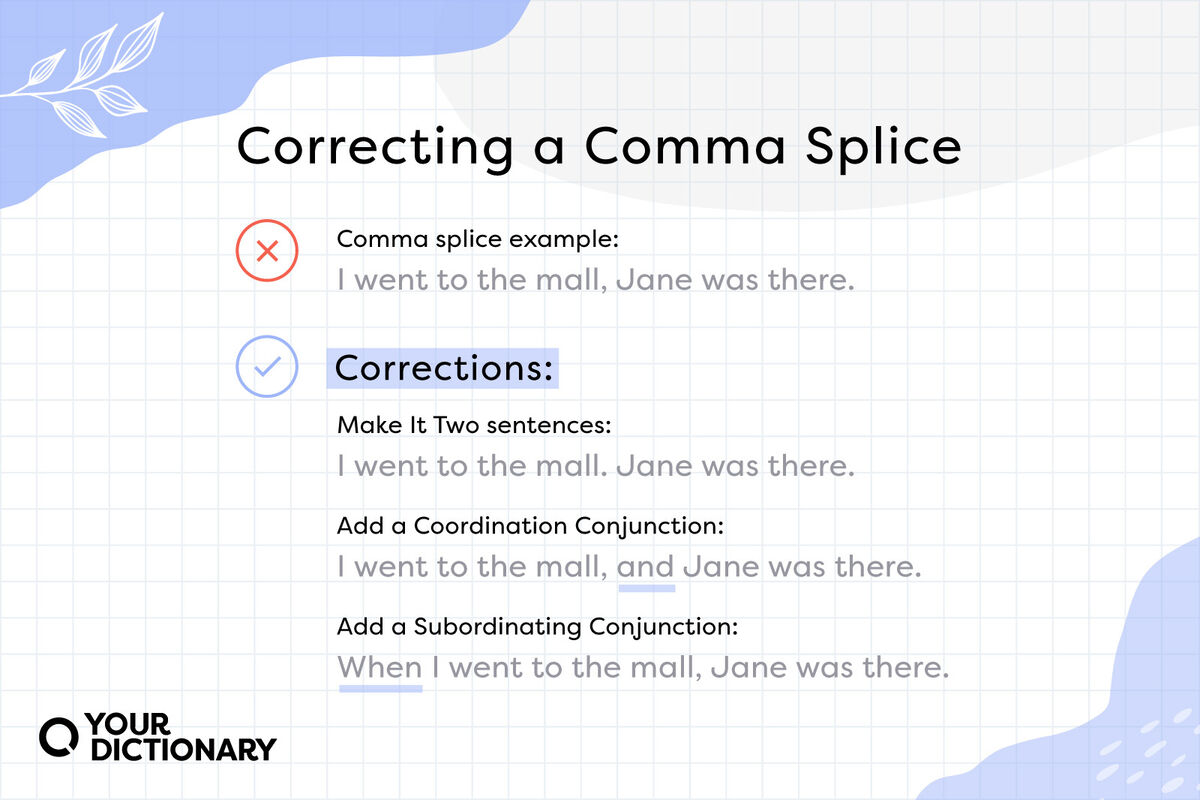
3. Run-on Sentences
Run-on sentences are lengthy sentences that lack proper punctuation or conjunctions to separate independent clauses (complete thoughts). They are difficult to read because they disrupt the flow of the text.
Besides affecting readability, run-ons can also make your writing sound immature or sloppy. They’re considered grammatically wrong and need fixing pronto.
Examples:
❌ She hurried to catch the train she was already late for work she didn’t realize it had been canceled.
❌ The sun was setting the sky turned shades of orange and pink she decided to take a photograph.
❌ I wanted to visit the museum it was closed for renovations so we went to the botanical garden instead.
❌ He ran to catch the bus he missed it by a few seconds his heart was pounding in his chest.
❌ She loves to read books she has a collection of classics she spends hours in the library.
Fix these run-on sentences by adding proper punctuation or conjunctions:
✅ She hurried to catch the train because she was already late for work, but she didn’t realize it had been canceled.
✅ The sun was setting, and the sky turned shades of orange and pink. She decided to take a photograph.
✅ I wanted to visit the museum, but it was closed for renovation, so we went to the botanical garden instead.
✅ He ran to catch the bus, but he missed it by a few seconds, and his heart was pounding in his chest.
✅ She loves to read books, she has a collection of classics, and she spends hours in the library.
By adding commas, periods, or conjunctions, you can turn run-on sentences into clear and concise text that you can read without trying to catch your breath.
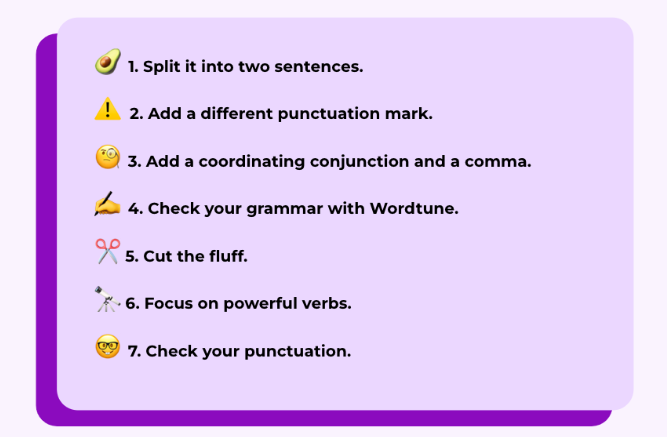
Use this cheatsheet from Wordtune to fix run-on sentences
4. Verb Tense Inconsistency
What is a verb tense?
In the English language, there are several verb tenses including past, present, and future, as well as their various forms (simple, continuous, perfect, and perfect continuous).
Ensuring verb tense consistency within a sentence, paragraph, or entire piece of writing is essential for clear and coherent communication. This means that if you start writing in the past tense, stick to it throughout your text.
Examples:
❌ She will go to the store yesterday to buy groceries. (“Will go” is future tense, “yesterday” is past tense)
❌ He is playing tennis, but he will be working on his project tomorrow. (“Is playing” is present continuous tense, “will be working” is future continuous tense)
❌ I have finished my homework, and now I will be studying for the exam last night. (“Have finished” is present perfect tense, “will be studying” is future continuous tense, “last night” is past tense)
❌ She went to the concert last night, and she will be going again next week. (“Went” is past tense, “will be going” is future continuous tense)
❌ They were playing basketball, and suddenly she sings a beautiful song. (“Were playing” is past continuous tense, “sings” is present simple tense)
In these examples, the inconsistency in verb tense usage can confuse readers, as the actions are not presented in a coherent timeline. Maintaining consistency in verb tense within a sentence ensures clear communication and a smoother reading experience.
Fix these sentences by ensuring consistent verb tense usage:
✅ She went to the store yesterday to buy groceries. (Changed “will go” to past tense “went”)
✅ He is playing tennis, but he will work on his project tomorrow. (Changed “will be working” to future simple tense “will work” to match the tense of the first verb)
✅ I have finished my homework, and now I will study for the exam tonight. (Changed “will be studying” to future simple tense “will study” and “last night” to “tonight” for proper time reference)
✅ She went to the concert last night, and she will go again next week. (Changed “will be going” to future simple tense “will go”)
✅ They were playing basketball, and suddenly she sang a beautiful song. (Changed “sings” to past tense “sang”)
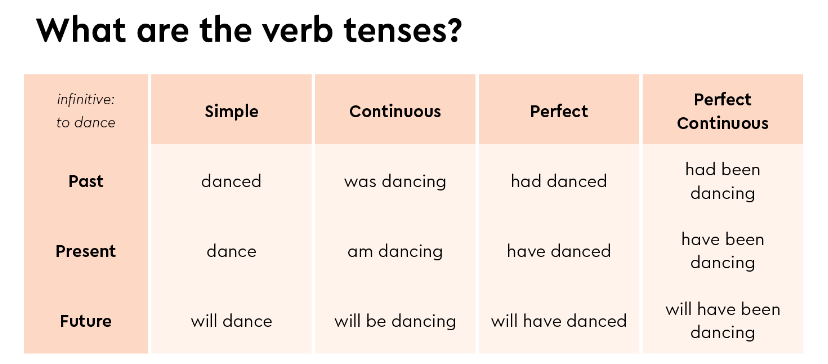
Screenshot from Thesaurus.com
5. Dangling and Misplaced Modifiers
Read this sentence: “Walking down the street, my shoes began to hurt.”
Wait. Your shoes took a stroll?
Nope. That sentence left us hanging with a dangling modifier.
A dangling modifier is a word or phrase that is intended to modify a noun, but the noun it is supposed to modify is not clearly stated in the sentence. As a result, the modifier appears to be “dangling” because it does not have a specific word or phrase to describe.
Dangling modifiers can lead to confusion and make your sentence sound silly.
Examples:
❌ After finishing the novel, the TV was turned on. (The TV finished the novel?)
❌ Tired and hungry, the pizza was devoured quickly. (The pizza was tired and hungry?)
❌ Rushing to catch the train, the keys were left on the kitchen counter. (The keys rushed to catch the train?)
❌ Confused by the instructions, the recipe was difficult to follow. (The recipe was confused?)
❌ Having studied for hours, the exam was aced. (The exam studied?)
In each of these examples, the modifier is dangling because the intended noun or pronoun that the modifier is supposed to describe is not stated clearly in the sentence.
Fix these dangling modifiers by identifying the subject and turning passive voice into active voice:
✅ After finishing the novel, she turned on the TV.
✅ Tired and hungry, they devoured the pizza quickly.
✅ Rushing to catch the train, he left the keys on the kitchen counter.
✅ Confused by the instructions, she found the recipe difficult to follow.
✅ Having studied for hours, he aced the exam.
Now let’s talk about misplaced modifiers — a common grammar faux pas that every writer should avoid.
Misplaced modifiers are words, phrases, or clauses that are separated from the words they describe, leading to confusion or awkwardness in a sentence.
These modifiers can be adjectives, adverbs, or phrases that provide additional information about a specific element in the sentence.
When they are not placed next to the word they are intended to modify, the meaning of the sentence can be unclear or distorted.
Examples:
❌ I found a gold man’s watch. (A golden man?)
❌ Alice napped with her cat, tired after a long day at work. (The cat was tired?)
❌ There’s nothing like a chocolate cone of ice cream on a hot day. (The cone is made of chocolate?)
❌ We glued together the vase we broke quietly. (They broke the vase quietly?)
❌ My uncle had to see a doctor with indigestion. (The doctor had indigestion?)
In these examples, the meaning of the sentence gets muddled because modifiers aren’t close enough to what they’re modifying.
Fix these misplaced modifiers by moving them to the proper place:
✅ I found a man’s gold watch.
✅ Tired after a long day at work, Alice napped with her cat.
✅ There’s nothing like a cone of chocolate ice cream on a hot day.
✅ We quietly glued together the vase we broke.
✅ My uncle was suffering from indigestion so he had to see a doctor.
Remember, if something is dangling, don’t leave it hanging — reel it in.
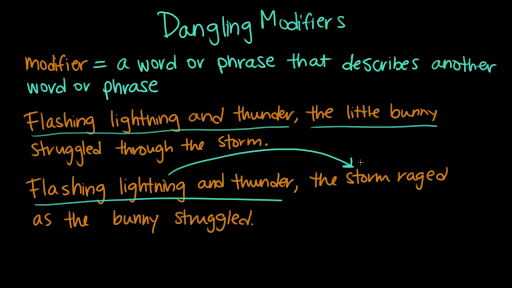
Illustration by Khan Academy
6. Incorrect Title Capitalization
The general rule for title capitalization in English dictates that the first and last words should always be capitalized, along with all major words in between. But let’s dive into specifics to avoid common grammar mistakes.
First off, capitalize any verbs, nouns, adjectives, pronouns, or subordinating conjunctions (like ‘as’ or ‘because’). These are considered key parts of the sentence structure and therefore need their spotlight.
Prepositions shorter than five letters such as for, and, or with typically don’t get capitalized unless they are positioned at the beginning or conclusion of a title. The same goes for articles (“a”, “an”, “the”) and coordinating conjunctions (“and”, “but”, “or”).
To ensure correct spelling every time you write a title: remember this simple trick – run your headline through the Capitalize My Title tool.
This nifty helper can save you from those embarrassing grammar errors that may make your content seem less credible.
7. Mixing Up Possessive Nouns and Contractions
One of the most common grammatical errors involves possessive nouns. These little grammar gremlins can be tricky, but let’s tackle them together.
A possessive noun, simply put, shows ownership or association. It could relate to people (John’s book), places (America’s cities), time (one year’s salary), or even ideas (love’s power).
To form a singular possessive noun, you typically add an apostrophe and an “s” (a dog’s bone).
But here’s where it gets interesting — for words ending in “s”, there are two schools of thought in forming possessive nouns.
Add an Apostrophe + S: This method involves adding an apostrophe and an “s” to the possessive noun.
Examples:
- James’s car
- The boss’s office
- The Beatles’s song
- The witness’s account
- The hostess’s invitation
Add Only an Apostrophe: Some style guides suggest adding only an apostrophe to the possessive noun.
Examples:
- James’ car
- The princess’ castle
- Horses’ stable
- Texas’ history
- Athletes’ achievements
Both approaches are considered grammatically correct although some editors prefer using only the apostrophe to maintain clarity and avoid excessive sibilance (that slithery “sss” sound 🐍) in pronunciation.
These grammatical rules cause much debate among writers as different style guides offer different recommendations. When in doubt, refer to the specific style guide followed by your school, publisher, or organization. If no specific guidelines are provided, choose one method and be consistent throughout your writing.
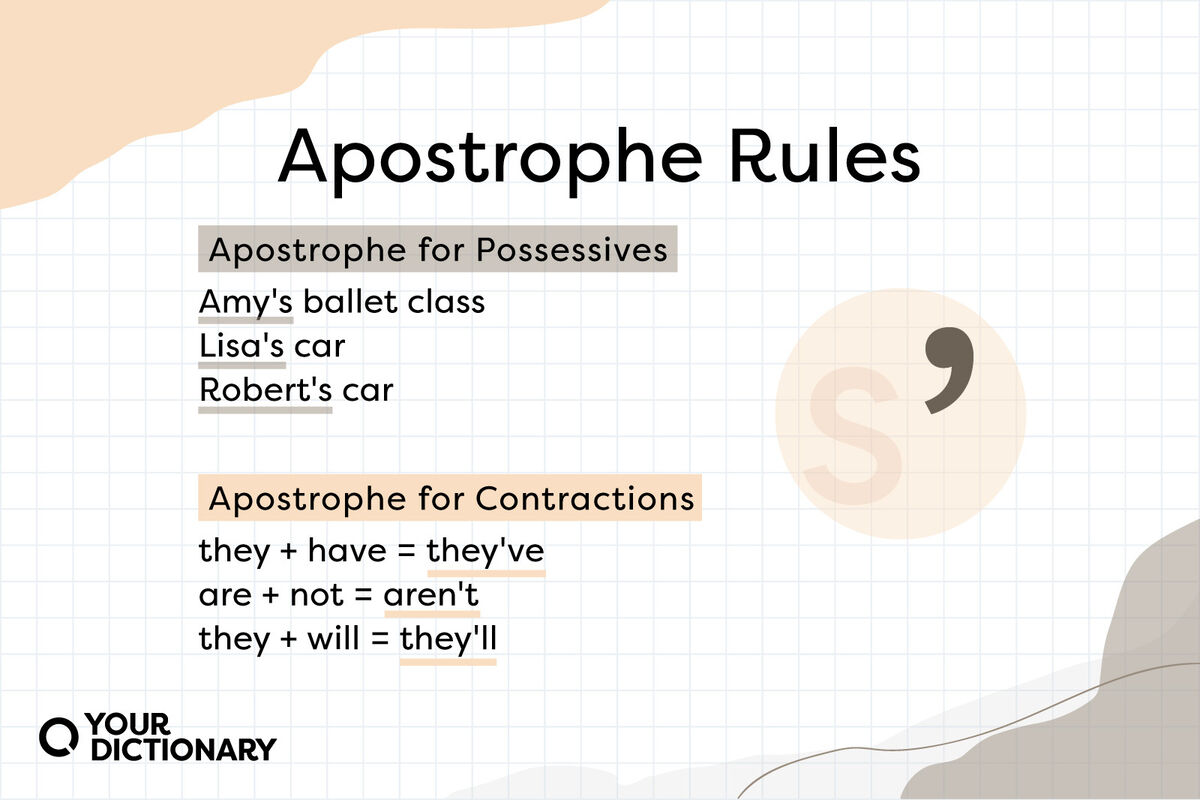
Mixing up possessive pronouns with contractions is another common mistake in English writing. Spell the wrong word and the meaning of your sentence totally changes.
Here are some common grammatical errors and how to avoid them:
Its vs. It’s
“It’s” is a contraction of “it is” or “it has,” while “its” is a possessive pronoun indicating ownership.
- If you mean to say “it is” or “it has,” use “it’s.”
- If you’re indicating possession, use “its” without an apostrophe.
❌ Incorrect: Its surprising how quickly the cat found it’s way back home after being lost for days.
✅ Correct: It’s surprising how quickly the cat found its way back home after being lost for days.
Your vs. You’re
“You’re” is a contraction of “you are,” whereas “your” is a possessive pronoun.
Pay attention to whether you intend to say “you are” (use “you’re”) or indicate possession (use “your”).
❌ Incorrect: Your going to love you’re new apartment.
✅ Correct: You’re going to love your new apartment.
Their vs. They’re
“They’re” is a contraction of “they are,” while “their” is a possessive pronoun indicating ownership.
Ensure you’re choosing the correct form based on whether you mean “they are” (use “they’re”) or possession (use “their”).
❌ Incorrect: Their planning to visit they’re grandparents over the weekend.
✅ Correct: They’re planning to visit their grandparents over the weekend.
Whose vs. Who’s
“Who’s” is a contraction of “who is” or “who has,” whereas “whose” is a possessive pronoun indicating ownership.
If you mean to say “who is” or “who has,” use “who’s”; if you’re indicating possession, use “whose.”
❌ Incorrect: Whose the person who’s phone was ringing during the meeting?
✅ Correct: Who’s the person whose phone was ringing during the meeting?
By understanding the distinctions between these pairs of words and practicing their correct usage, you can avoid common mistakes when using possessive pronouns and contractions in your writing.
8. Missing Commas with Transition Words
Writing a sentence isn’t just about stringing words together. The order matters, and introductory elements play a big part.
An introductory element, as the name suggests, is the first word or phrase of a sentence that often sets up what’s to come. This can be an adverb, phrase, or even a clause.
Here are some of the most common transition words in the English language and how they are used at the start of a sentence:
- However: However, the weather forecast predicts rain for the weekend.
- Therefore: Therefore, we need to prepare for the upcoming presentation.
- Meanwhile: Meanwhile, I’ll be working on the research paper.
- Furthermore: Furthermore, the study also highlighted the importance of exercise.
- Moreover: Moreover, his dedication to the project impressed everyone.
- Nevertheless: Nevertheless, she persisted in completing the marathon.
- Additionally: Additionally, we can schedule a meeting to discuss the details.
- In addition: In addition, please provide your feedback by the end of the week.
- On the other hand: On the other hand, some people prefer working in a team.
- Conversely: Conversely, others enjoy working independently.
- In contrast: In contrast to your opinion, I believe the movie was excellent.
- Nonetheless: Nonetheless, he managed to finish the assignment on time.
- In conclusion: In conclusion, I want to emphasize the importance of this issue.
- To sum up: To sum up, the results indicate a positive trend.
- In summary: In summary, the project is progressing smoothly.
These transitional words help connect ideas and improve the flow of your writing, guiding readers through your thoughts and arguments. The choice of transitional words depends on the context and the relationship between the sentences or paragraphs.
The most common mistake here is the missing comma after these introductory words.
The rule of thumb with transition words is pretty simple: if your introductory element gives context but could be removed without changing the meaning of the main clause, it likely needs to be followed by a comma for clarity.
We’ve talked about single-word introductions so far. But what happens when we deal with longer phrases or clauses?
If an introductory phrase leads naturally into the rest of your sentence, it doesn’t necessarily need punctuation marks.
But more complex sentences?
It’s always best practice to include that helpful little comma for better readability.
9. Misusing Coordinating Conjunctions
Coordinating conjunctions are words that connect words, phrases, or clauses that are similar or equal in structure within a sentence.
They are essential for combining ideas, creating compound sentences, and showing the relationships between different parts of a sentence.
There are seven coordinating conjunctions in English, often remembered by the acronym FANBOYS, which stands for:
- For: Indicates reason or cause.
- She stayed home, for she was feeling unwell.
- And: Adds one thing to another or indicates a logical connection.
- He likes both coffee and tea.
- Nor: Used in negative constructions and means “and not” or “or not.”
- She neither likes coffee nor tea.
- But: Indicates contrast or exception.
- She is tired, but she can’t sleep.
- Or: Presents an alternative or indicates a choice.
- Do you want coffee or tea?
- Yet: Adds a contrasting idea.
- She is tired, yet she keeps working.
- So: Indicates a consequence or result.
- It was raining, so we stayed indoors.
Coordinating conjunctions are a crucial part of English grammar, but their misuse can lead to confusion.
Here are some common grammar errors when using coordinating conjunctions.
Mismatched Conjunctions
Choosing the right coordinating conjunction is essential for conveying the intended relationship between the connected elements. For instance, using “and” when “but” or “so” is more appropriate can alter the meaning of the sentence.
❌ Incorrect: I failed the exam, and I’m feeling down.
✅ Correct: I failed the exam, so I’m feeling down.
In this case, “and” suggests a simple addition of information, while “so” clearly indicates a cause-and-effect relationship.
❌ Incorrect: He didn’t like tea nor coffee.
✅ Correct: He liked neither tea nor coffee.
In this example, using “nor” requires the initial negative element (“neither”) to be included. The correct negative construction is necessary for appropriate conjunction usage.
Unnecessary Conjunctions
Sometimes, conjunctions can be redundant or unnecessary. Overusing them can make writing clunky and obscure the intended meaning.
❌ Incorrect: The cat is black and white but it is also very fluffy.
✅ Correct: The cat is black and white and very fluffy.
In this case, the coordinating conjunction “but” can be omitted without affecting the meaning of the sentence.
Conjunctions at the Beginning of Sentences
While not strictly grammatically incorrect, starting sentences with coordinating conjunctions is often discouraged. It can make writing sound abrupt and choppy, especially when done repeatedly.
❌ Incorrect: And, I’m ready to start the presentation.
✅ Correct: I’m ready to start the presentation.
In this instance, omitting the conjunction creates a smoother flow and emphasizes the main point of the sentence.
Inconsistent Usage
Using different coordinating conjunctions to connect items of the same type can be confusing and disrupt the rhythm of the writing.
❌ Incorrect: I like apples, pears, and I also enjoy oranges.
✅ Correct: I like apples, pears, and oranges.
Using “and” consistently throughout the list maintains clarity and consistency.
Coordinating conjunctions can serve as powerful tools for structuring sentences and conveying relationships between ideas. By avoiding these common mistakes, you can enhance your writing’s clarity, accuracy, and overall effectiveness.
10. Mixing Up Hyphens and Dashes
Another common grammar mistake is mixing up hyphens and dashes and their different functions in a sentence.
Understanding the correct usage of the hyphen, en dash, and em dash is crucial for effective written communication. These punctuation marks may seem small, but they can greatly impact the meaning of your sentences if used incorrectly.
A hyphen, though tiny, serves a significant purpose in writing. It’s used to join words together or split them apart. It helps create compound terms like “merry-go-round”, “mother-in-law”, and “sixty-four.”
For example: We want to hold a princess-themed party for our kid next year.
An en dash is slightly longer than a hyphen but shorter than an em dash. En dashes are often used for indicating a range of values.
For example: Refer to pages 20–25 for further details.
An em dash is longer than a hyphen and serves different functions, one being indicating pauses within sentences, similar to semicolons or commas.
For example: We’d love to see you tonight — come over any time after eight.
This sentence uses a dash instead of a comma or semicolon because it adds emphasis on the invitation while creating an informal tone which would be perfect in casual conversation.
Proper use of these two often-confused punctuation marks can make your writing clearer and more professional-looking.
Don’t let their size fool you — they play big roles in English grammar.
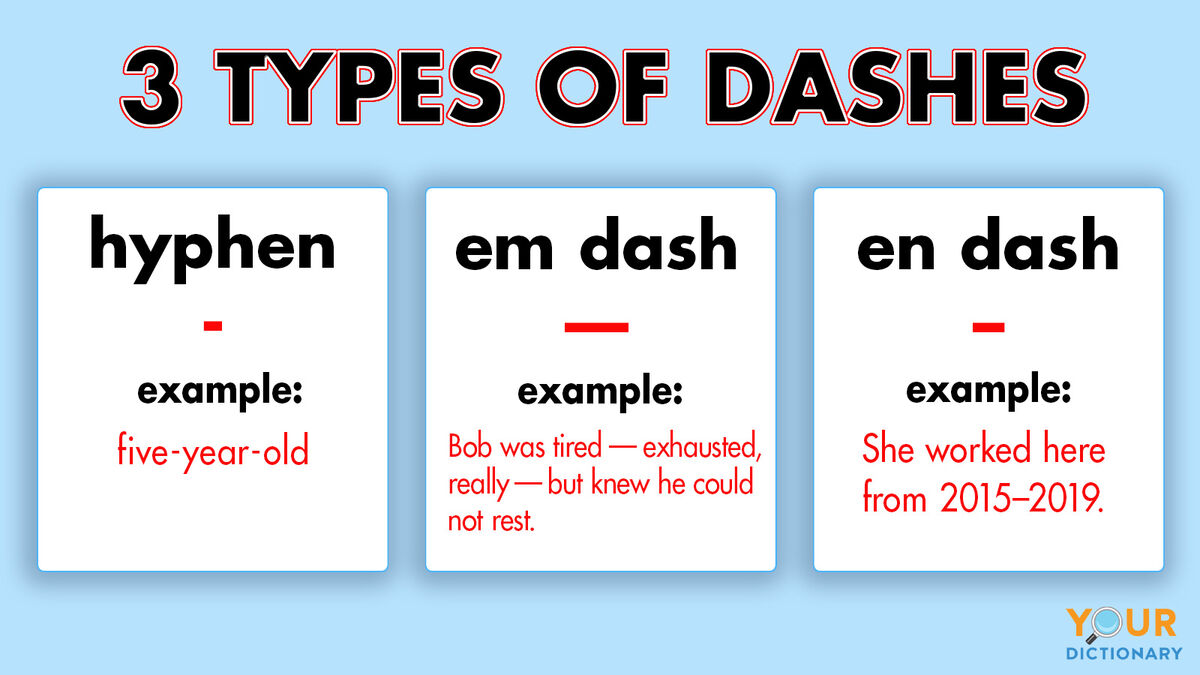
11. Incomplete Comparisons
Another common pitfall that writers often stumble upon is incomplete comparisons. This mistake occurs when a comparison is initiated but isn’t explicitly finished, leaving readers unsure about what exactly is being compared.
For instance, if you say “Our product is better,” it raises an immediate question: Better than what?
The reader needs to know what your product is being compared against for the statement to make sense and be effective.
The correct sentence would be “Our product is better than our competitors’ offerings.”
Here are more examples of how to fix incomplete comparisons:
❌ Incorrect: Our car runs smoother.
✅ Correct: Our car runs smoother than your truck.
❌ Incorrect: He can run faster.
✅ Correct: He can run faster than his brother.
❌ Incorrect: This recipe tastes more delicious.
✅ Correct: This recipe tastes more delicious than the one I made last night.
To avoid falling into this grammatical trap, always remember to complete your comparisons by stating clearly who or what you are comparing with. This will not only enhance clarity but also improve your writing’s persuasiveness.
12. Mixing Up Homonyms
Homonyms are words that sound exactly the same but have different spellings and meanings. A common mistake even for native speakers is mixing up these words in written communication.
To help you avoid these grammar errors, here’s a brief guide to help you understand their differences.
There vs. Their
“There” is an adverb that refers to a place or position: “Look over there!”
“Their” is a possessive pronoun used to indicate ownership like in this sentence: “Don’t touch their food.”
To, Too, Two
“To” is a preposition or part of an infinitive verb: “She went to the store.“
“Too” means also or excessively. “You drink way too much caffeine!“
“Two” refers to the number 2. “I have two siblings.”
Then vs. Than
“Then” refers to time or a sequence of events: “And then what happened?”
“Than” is used when making comparisons: “You’re taller than your brother.”
Weather vs. Whether
“Weather” is a noun describing atmospheric conditions: “How’s the weather today?“
“Whether” is used to introduce alternatives or choices: “Have you decided whether you want to ski or snowboard?“
Accept vs. Except
“Accept” means to receive or agree to something: “She will accept the award.”
“Except” means excluding: “Everyone is going except Mary.”
Affect vs. Effect
“Affect” is a verb that means to influence or make a change in something: “The news deeply affected her.”
“Effect” is a noun that represents a change that occurred due to an action: “The new law had a positive effect on the community.”
Lose vs. Loose
“Lose” is a verb that means to be unable to find or to suffer a loss: “Don’t lose your keys.”
“Loose” is an adjective that means not tight or free from restraints: “His pants are too loose.”
Passed vs. Past
“Passed” is the past tense of pass: “She passed the exam with flying colors.”
“Past” refers to a time before the present: “In the past, people relied on handwritten letters.”
Principal vs. Principle
“Principal” refers to the head of a school or an important person in an organization: “The principal will address the students in the auditorium.”
“Principle” refers to a fundamental truth, law, or rule: “He believed in the principles of honesty and integrity.”
Peek, Peak, Pique
“Peek” means to glance quickly or sneak a look: “She couldn’t resist taking a peek at the surprise.”
“Peak” refers to the top of a mountain or the highest point: “They reached the peak after hours of climbing.”
“Pique” is to arouse interest, curiosity, or resentment: “His curiosity was piqued by the mysterious story.”
Cite, Sight, Site
“Cite” means to quote as evidence or reference: “She had to cite her sources in the research paper.”
“Sight” refers to vision or something seen: “The view from the hilltop was a breathtaking sight.”
“Site” refers to a specific location or place: “The construction site is where the new building will be erected.”
Complement vs. Compliment
“Complement” is something that completes or goes well with something: “The red wine complemented the flavor of the steak.”
“Compliment” is a polite expression of praise or admiration: “She received a compliment on her new hairstyle.”
Conclusion
We all have our linguistic Achilles’ heel. Maybe for you, it’s knowing when to use “lose” versus “loose”, or understanding how semicolons work.
Another common issue is the Oxford comma. What is an Oxford comma and when should you use it?
By identifying these weaknesses, we become better writers.
Being mindful of these common grammar mistakes can significantly enhance the clarity and effectiveness of your writing. Regular proofreading and attention to these details can help you produce polished and professional content, whether it’s for academic, professional, or personal purposes.
The road to perfect grammar may be winding, but with patience and practice, you’ll get there.